29 July 2024 : Daily Current Affairs
1. ‘Secret changes have been made to draft Broadcasting Bill’
(Source – The Hindu, International Edition – Page No. – 6)
| Topic: GS2 – Indian Polity |
| Context |
|
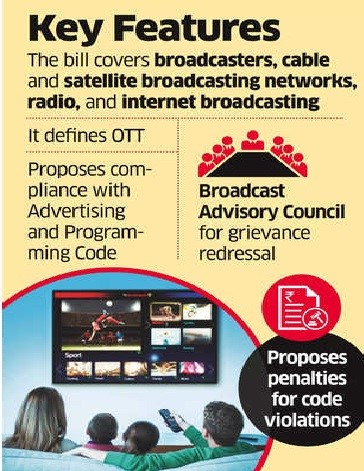
IFF’s Criticism of the Draft Broadcasting Services (Regulation) Bill
- The Internet Freedom Foundation (IFF) criticises “secret” alterations to the draft Broadcasting Services (Regulation) Bill.
- Concerns over lack of transparency and inclusivity in the process.
- The Information and Broadcasting Ministry engaged only selective industry representatives, excluding civil society, journalists, and other key stakeholders.
- Fears of increased censorship on online platforms due to these secretive changes.
- Civil society groups raise alarms about stricter censorship implications for online news and entertainment media.
Replacement of Cable Television Networks (Regulation) Act, 1995
- Publicly released version of the Bill aims to replace the Cable Television Networks (Regulation) Act, 1995.
- Streaming services required to form “content evaluation committees” to pre-screen content before release.
Establishment of Broadcast Advisory Council
- Bill proposes creating a Broadcast Advisory Council with government members to address complaints against broadcasters.
- Regulatory power could extend to streaming platforms and online influencers through notifications from the I&B Ministry.
- Concerns are being raised by content creators, warning the new law could shut down YouTube journalists.
Compliance and Penalties
- Broadcasters under the Ministry’s regulatory scope must adhere to a Code prescribed by the Union government.
- Non-compliance could result in monetary penalties or imprisonment.
- IFF highlights concerns over severe penalties, suggesting they could stifle freedom of expression and lead to self-censorship.
Government’s Stance on “Negative Influencers”
- The Union government strongly opposes “negative influencers”.
- A 2021 government report states some influencers spread false narratives and discredit the government.
- Emphasis on the need for constant tracking and timely responses to these narratives.
Draft Broadcasting Services (Regulation) Bill, 2023
The draft Bill also seeks to regulate broadcast of news and current affairs programmes (excluding print news). Such programmes will have to comply with the prescribed programme code and advertisement code.
The draft Bill provides for a self-regulatory structure to ensure compliance with the programme and advertisement codes. This includes:
-
-
Self-regulation,
-
Constituting self-regulatory organisations, and
-
Establishing a Broadcast Advisory Council.
-
Each broadcaster will have to also set up an internal Content Evaluation Committee (CEC). All broadcast content must be certified by the CEC.
Conclusion
- Draft Broadcasting Services (Regulation) Bill represents a significant shift in online media regulation in India.
- IFF and civil society groups voice substantial concerns about lack of transparency and potential increased censorship.
- Calls for broader consultation and consideration of diverse viewpoints in the legislative process.
| Practice Question: Discuss the potential implications of the draft Broadcasting Services (Regulation) Bill on online media freedom in India. How might this bill affect transparency and stakeholder inclusivity in media regulation? (150 Words /10 marks) |
2. CITES eases norms for agarwood export; move to benefit lakhs of farmers from the Northeast
(Source – The Hindu, International Edition – Page No. – 6)
| Topic: GS3 – Environment and Ecology |
| Context |
|
Successful Prevention of Agarwood Inclusion in RST
- India successfully prevented the inclusion of agarwood (Aquilaria malaccensis) in the Review of Significant Trade (RST) of the Convention on International Trade in Endangered Species of Wild Fauna and Flora (CITES).
- This decision was based on a non-detriment findings (NDFs) study by the Botanical Survey of India (BSI) and the Ministry of Environment Forest and Climate Change (MoEFCC).
New Export Quota Notification
- CITES notified a new export quota for agarwood resinous wood and oil from India, effective from April 2024.
- This development benefits farmers in northeastern states like Assam, Manipur, Nagaland, and Tripura where agarwood is cultivated.
Aquilaria Malaccensis in CITES Appendix II
- Aquilaria malaccensis was listed in Appendix II of CITES in 1995, based on India’s proposal at CoP9 in 1994.
- Appendix II includes species not necessarily threatened but whose trade must be controlled to avoid utilisation incompatible with their survival.
| CITES: |
|
CITES: Convention on International Trade in Endangered Species of Wild Fauna and Flora.
Appendices:
|
Findings and Recommendations from the NDF Study
- The NDF suggested harvesting agarwood from home, community gardens, plantations on leased lands, and private or community plantations.
- It advised against harvesting from wild populations or protected areas and reserve forests.
- The recommended export quota for 2024–2027 is 1,51,080 kg of agarwood chips and powder/sawdust per year, and 7,050 kg of agarwood oil per year.
Impact of Previous Trade Restrictions
- The absence of an export quota and other trade restrictions led to an increase in informal trade and exports to the Middle East and other countries.
- This situation also caused a rise in the global market prices of agarwood chips and oil as India is a major trading nation for agarwood.
Continued Illegal Trade Despite Export Ban
- Despite the export ban, illegal trade of agarwood continued in India.
- Between 2017 and 2021, over 1.25 tonnes of agarwood chips and six litres of oil/derivatives were seized in six states, according to a report by TRAFFIC, an NGO.
Conclusion
- The new export quota and the successful prevention of agarwood’s inclusion in the RST are expected to stabilise the trade and benefit Indian farmers.
- Ongoing efforts are needed to combat illegal trade and ensure sustainable practices.
3. Surprising ‘dark oxygen’ discovery could ensnarl deep-sea mining
(Source – The Hindu, International Edition – Page No. – 7)
| Topic: GS3 – Science and Technology |
| Context |
|
Discovery of Oxygen Production in Deep Oceans
- Scientists reported on July 22 in Nature Geoscience that an unknown process is producing oxygen deep in the world’s oceans, where photosynthesis is not possible due to insufficient light.
- This discovery has significant implications as oxygen is crucial for supporting life and suggests the existence of previously unknown ecosystems.
Potential Source of Oxygen
- One hypothesis for the oxygen production involves polymetallic nodules, which are lumps of iron, manganese hydroxides, and rock found on the ocean floor.
- These nodules might be transporting electric charges that split water molecules, releasing oxygen.
- Polymetallic nodules are considered economically viable for mining if their concentration exceeds 10 kg per square metre, and many countries are exploring this resource.
Study Location and Findings
- The study was conducted in the Clarion-Clipperton Zone off Mexico’s west coast, an area with the highest concentration of polymetallic nodules, including significant amounts of manganese, copper, and nickel.
- Scientists observed unexpected increases in oxygen concentration at a depth of 4 km, where oxygen levels should normally drop due to low sunlight and consumption by marine life.
- Follow-up studies confirmed these findings, showing oxygen levels increasing, sometimes tripling in two days.
- The study, led by Andrew Sweetman and colleagues, suggests the existence of a new source of oxygen, termed ‘dark oxygen’.
Implications for Deep-Sea Mining
- The discovery raises concerns about the impact of deep-sea mining on marine ecosystems that rely on ‘dark oxygen’.
- The International Seabed Authority has awarded 15-year contracts to at least 22 contractors, including India, to explore and mine polymetallic nodules and other resources from the deep seabed.
- China is expected to mine 17% of the Clarion-Clipperton Zone.
- Deep-sea mining could potentially harm ecosystems that depend on ‘dark oxygen’.
Recent Developments and Concerns
- In November 2023, it was reported that deep-sea mining might harm deep-sea jellyfish, according to recent research.
- The lack of comprehensive knowledge about abyssal zone ecosystems makes predictions about their fate and role in climate processes uncertain.
- In response to these concerns, three major European insurance companies announced they would exclude deep-sea mining from their underwriting portfolios.
Conclusion
- The discovery of ‘dark oxygen’ and the potential impacts of deep-sea mining highlight the need for sustainable practices and further research to mitigate possible environmental harm.
- Without adequate measures, deep-sea mining may face significant challenges and may become infeasible.
| Practice Question: Assess the implications of the recent discovery of oxygen production in the deep ocean linked to polymetallic nodules for deep-sea mining activities and marine ecosystems. (150 Words /10 marks) |
4. On reservations and the OBC creamy layer
(Source – The Hindu, International Edition – Page No. – 10)
| Topic: GS2 – Indian Polity |
| Context |
|
History of Reservation
- Articles 15 and 16 of the Indian Constitution guarantee equality for all citizens and special provisions for the advancement of socially and educationally backward classes, including Other Backward Classes (OBC), Scheduled Castes (SC), and Scheduled Tribes (ST).
- Reservations for SC and ST are fixed at 15% and 7.5% respectively in central government jobs, educational institutions, and public sector undertakings (PSUs).
- In 1990, the Prime Minister V. P. Singh implemented a 27% reservation for OBCs in central government employment based on the Mandal Commission’s recommendations from 1980.
- In 2005, the reservation policy was extended to include educational institutions, both public and private, for OBC, SC, and ST categories.
- In 2019, a 10% reservation was introduced for the Economically Weaker Sections (EWS) among the unreserved category.
Creamy Layer Exclusion
- The Supreme Court upheld the 27% reservation for OBCs in the Indra Sawhney case in 1992, setting a 50% cap on total reservations and mandating the exclusion of the creamy layer from OBC benefits.
- The creamy layer criteria were established by the Justice Ram Nandan Prasad Committee in 1993.
- This is determined based on the parental income exceeding ₹8 lakh annually over the past three years and specific job positions or constitutional posts held by parents.
- Categories considered part of the creamy layer include parents who are Group A/Class I or Group B/Class II officers, those in managerial positions in PSUs, or those holding constitutional posts.
Issues with the Reservation System
- Recent controversies have highlighted issues with obtaining Non-Creamy Layer (NCL) or EWS certificates through questionable means, similar concerns exist regarding disability certificates for reserved seats.
- Strategies to circumvent creamy layer exclusions, such as asset gifting or premature retirement, are reported, as the exclusion criteria focus on parental income and job positions.
- The Rohini Commission found that a significant percentage of reserved jobs and seats are concentrated among a small number of OBC castes, with around 1,000 out of 2,600 OBC communities having no representation. Similar concentration issues are noted for SC and ST categories.
- The current reservation rate, including for EWS, stands at 60%. Government data indicates that 40-50% of reserved seats for OBC, SC, and ST in central government jobs remain unfilled.
Recommendations for Improvement
- To address these issues, it is necessary to tighten scrutiny to prevent ineligible individuals from obtaining NCL, EWS, and disability benefits.
- Ensuring that reserved vacancies are filled promptly is crucial.
- Consideration of sub-categorisation within OBCs could help address underrepresentation and distribute benefits more equitably.
- A discussion on whether to implement creamy layer exclusions for SC and ST categories, especially for children of senior government officials, should be initiated.
- Engaging with stakeholders to discuss and implement these recommendations can help ensure that reservation benefits reach the most marginalised groups effectively.
5. Leveraging Educated Mothers: Boosting Foundational Literacy and Numeracy Through NEP 2020 and NIPUN Bharat Mission
(Source: Indian Express; Section: Explained; Page: 11)
|
Topic: GS2 – Governance – Government policies |
|
Context: |
|
Analysis of News:
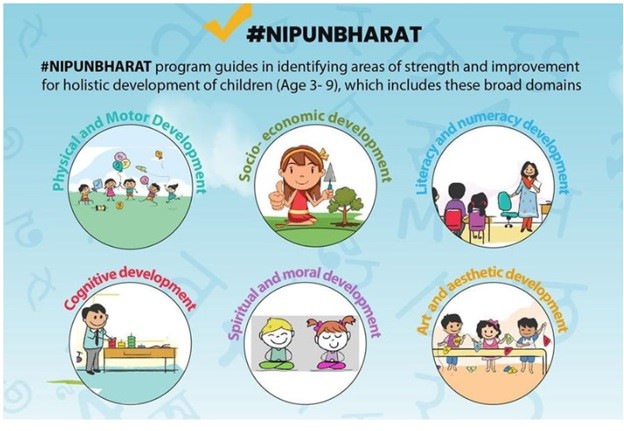
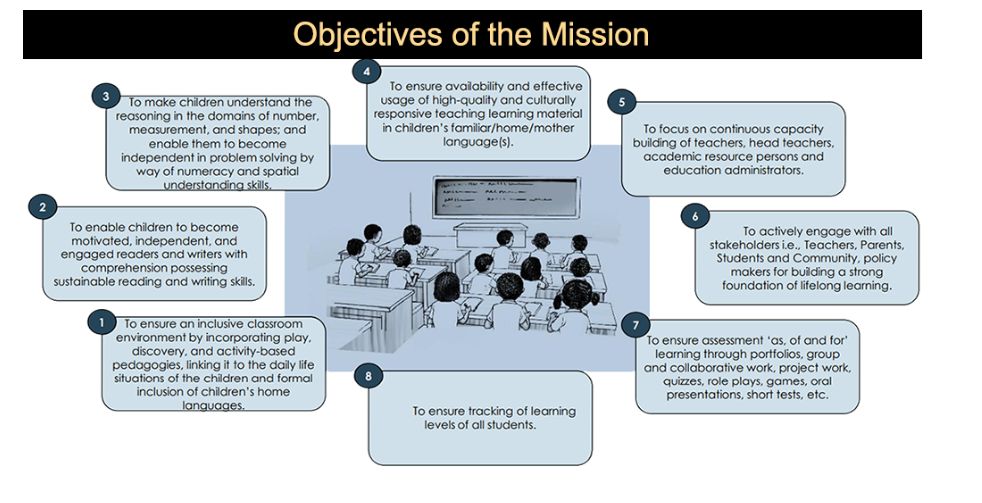
What is Nipun Bharat Mission?
Analysis of NEP 2020 and NIPUN Bharat Mission
NEP 2020 and NIPUN Bharat Mission Overview:
- Launch Date: NEP 2020 was launched on July 29, 2020.
- Objective: Ensure foundational literacy and numeracy skills by Grade 3.
- Implementation: NIPUN Bharat Mission launched on July 5, 2021.
- Initiatives: Teacher training, specialized teaching materials, new educational frameworks.
Educational and Social Trends:
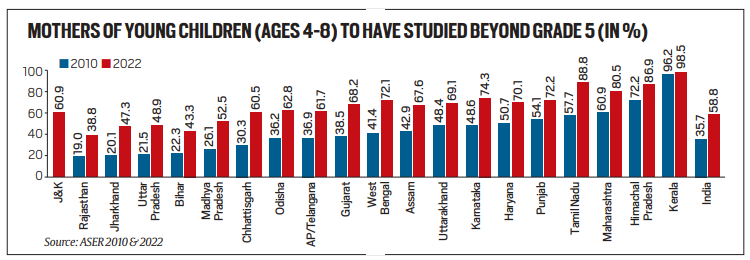
- School Enrollment: Significant increase in school enrollment rates since 2001, with over 90% in rural areas by early 2000s.
- Mother’s Education Levels:
-
- Increased education among mothers of children aged 4-8.
- From 2010 to 2022, mothers with education beyond Grade 5 rose from 35% to nearly 60%.
- Mothers completing over 10 years of schooling increased from less than 10% in 2010 to over 20% in 2022.
- High percentages of educated mothers in states like Kerala (72%), Himachal Pradesh (54%), and Tamil Nadu (43%).
Female Labor Force Participation:
- Low Participation: Female LFPR in India is 37% overall (41.5% rural, 25.4% urban).
- Young Women: LFPR for women aged 15-29 is 24.5% (25.8% rural, 20.8% urban).
Leveraging Educated Mothers:
- Economic Implications: Low female LFPR is a public policy concern.
- Mother’s Role in Education:
- Educated mothers as a resource for children’s learning.
- Fathers less available due to higher workforce participation (65.5% in rural areas).
- Pandemic increased parental involvement in education.
Recommendations:
- Encourage active participation of mothers in education.
- Foster collaboration between teachers and mothers to achieve NIPUN Bharat Mission goals.
|
What is National Education Policy 2020? |
|
The new National Education Policy (NEP) 2020 is the first education policy of the 21st century in India, which replaces the previous National Policy on Education (NPE) 1986.
|
|
PYQ: How have digital initiatives in India contributed to the functioning of the educational system in the country? Elaborate your answer. (250 words/15m) (UPSC CSE (M) GS-1 2020) |
|
Practice Question: Discuss the impact of the National Education Policy (NEP) 2020 and the NIPUN Bharat Mission on foundational literacy and numeracy in India. How can the increasing education levels of mothers be leveraged to enhance early childhood education, considering the current trends in female labor force participation? (250 words/15 m). (250 words/15 m) |
6. Supreme Court to Decide if the Right to be Forgotten Is a Fundamental Right in India
(Source: Indian Express; Section: Explained; Page: 11)
|
Topic: GS2 – Polity |
|
Context: |
|
Analysis of News:
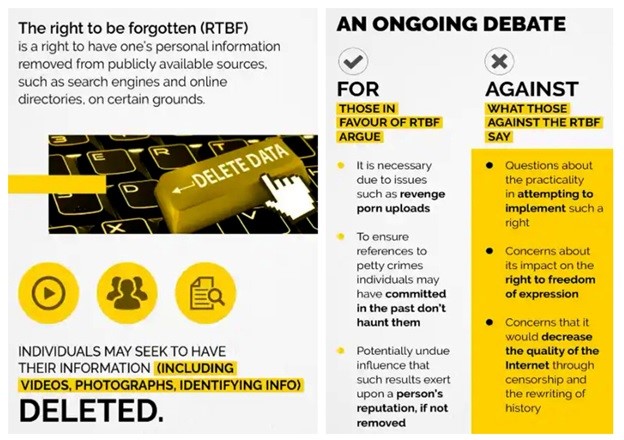
Case Background:
- Supreme Court’s Role: The SC will determine if the right to be forgotten is a fundamental right in India and how it relates to other constitutional rights.
- Specific Case: Challenge to Madras HC’s order for Indian Kanoon to remove a 2014 judgment affecting a man’s citizenship application.
Right to be Forgotten:
- Definition: The right to remove digital footprints violating privacy.
- EU Precedent: Established by the CJEU in 2014 (Google Spain case), emphasizing the removal of outdated, irrelevant, or excessive personal data.
Indian Context:
- Legal Framework: No explicit statutory right to be forgotten.
- Puttaswamy Judgment (2017): Recognized the right to privacy as fundamental, implying the right to be forgotten.
- Justice Kaul’s Opinion: Supported the right under specific conditions, balancing privacy with public interest and legal obligations.
Judicial Precedents:
- RRajagopal vs. State of Tamil Nadu (1994): Affirmed privacy rights but distinguished public records like court decisions from privacy protection.
Conflicting High Court Rulings:
- Gujarat HC (2017): Denied removal of acquittal details, citing public domain rights.
- Karnataka HC (2017): Protected petitioner’s identity in an annulment case.
- Delhi HC (2021): Allowed removal of acquittal details to prevent social and career harm.
- Orissa HC (2020): Called for a debate on implementing the right to be forgotten, especially in sensitive cases like revenge porn.
Implications:
- Balancing Rights: The SC’s decision will shape the balance between privacy and public interest in digital information.
- Future Legal Framework: Could lead to clearer regulations and protections for personal data in India.
|
Challenges |
|
|
Practice Question: Evaluate the potential implications of the Supreme Court’s decision on whether the right to be forgotten should be recognized as a fundamental right in India. How might this decision impact the balance between privacy and public interest, and what could be its broader effects on data protection and legal transparency in the country? (250 words/15 m) |
7. Cereals Surpass Sugarcane as Primary Feedstock for Ethanol Production in India
(Source: Indian Express; Section: Express network; Page: 04)
|
Topic: GS3– Agriculture |
|
Context: |
|
Analysis of News:
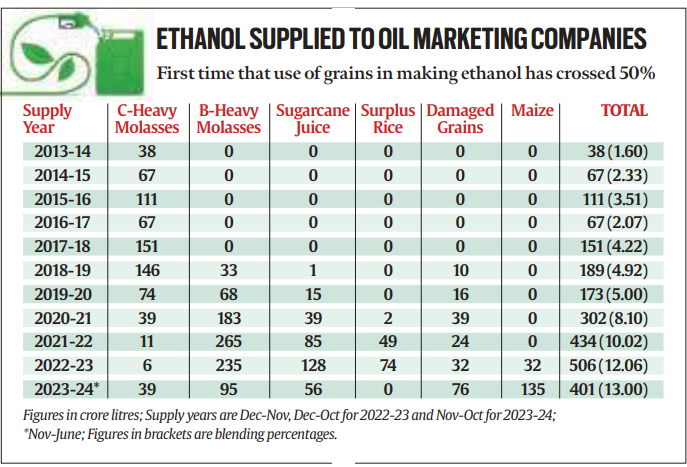
Ethanol Production Shift in India
- Primary Feedstock Shift: Cereals, primarily maize and damaged food grains, have overtaken sugarcane as the main feedstock for ethanol production. In the 2023-24 supply year, 52.7% of ethanol (211 crore litres) was from cereals, while sugarcane-based feedstocks contributed 47.3% (190 crore litres). This marks a significant increase from previous years, where cereals contributed 27.1% in 2022-23 and even less in earlier years.
- Ethanol Blending Goals: The Indian government, led by Prime Minister Narendra Modi, aims for 20% ethanol blending in petrol by 2025. As of June 2023, the blending rate averaged 13%, up from 12.1% in 2022-23 and 10% in 2021-22. The blending rate has been steadily increasing monthly.
- Production Process: Ethanol is produced through fermentation of sugars present in various feedstocks. While sugarcane molasses and cane juice have been traditional feedstocks, maize and other grains require conversion of starch into simpler sugars before fermentation.
- Policy Changes and Economic Factors: The shift to cereal-based ethanol was accelerated by the Modi government’s policy changes, including the restriction of Food Corporation of India (FCI) rice supply and limited use of sugarcane products for ethanol, aimed at controlling inflation in cereals and sugar. The government has set higher prices for ethanol from maize (Rs 71.86 per litre) compared to other feedstocks.
- Industry Response and Challenges: Companies have adapted by setting up multi-feedstock distilleries. However, this shift has led to concerns from the poultry and livestock feed industries about maize shortages. India’s maize production is estimated at 36 million tonnes, below the required 41 million tonnes. The government has allowed limited maize imports at a reduced duty to address this issue.
- Implications: While beneficial for ethanol production and maize farmers, the shift raises concerns about food security and availability of grains for other industries.
|
Practice Question: Discuss the shift from sugarcane to cereals as the primary feedstock for ethanol production in India. What are the implications of this transition for the agricultural sector, food security, and the country’s biofuel policy objectives? (250 words/15 m) |
Prelims Facts
1. Manu’s historic bronze opens India’s medal hunt
(Source – The Hindu, International Edition – Page No. – 1)
| Context |
|
Analysis of the news:
- Manu Bhaker won a bronze medal in the women’s 10m air pistol event at the Paris 2024 Olympics.
- This marks her first Olympic medal and the first won by an Indian woman shooter.

- She previously finished medalless at the Tokyo 2020 Olympics.
- Manu qualified for the final in third place and maintained medal contention throughout the event.
- She was in silver medal position until her final shot, missing silver by 0.1 to South Korea’s Kim Yeji.
- Another South Korean, Ye Jin Oh, won gold.
- Manu will also compete in the women’s 10m pistol mixed team and 25m pistol events.
2. Ariel: another watery moon?
(Source – The Hindu, International Edition – Page No. – 7)
| Context |
|
Analysis of the news:
- The Sun’s corona’s high temperature and Titan’s thick atmosphere are unresolved Solar System mysteries.
- Triton’s retrograde rotation is explained by its shared origin with Pluto before being captured by Neptune.
- Another mystery involves Uranus’s moon Ariel, which has frozen CO2 on its surface despite its distance from the Sun.
- On July 24, NASA’s James Webb Space Telescope (JWST) detected signs of a liquid ocean beneath Ariel’s surface.
- Carbon monoxide discovery suggests Ariel’s surface temperature might be 18 degrees Celsius lower than currently estimated, or that a subsurface ocean is producing carbon oxides.
- Cracks and grooves on Ariel could allow icy slope and compounds to escape to the surface.
- JWST also found carbonite minerals, indicating possible interaction between water and rocks.
- Further studies and missions are required to verify these findings and explore if Ariel is another water-bearing moon.
3. What is South Africa’s new law on climate change?
(Source – The Hindu, International Edition – Page No. – 10)
| Context |
|
Analysis of the news:
- South Africa’s President Cyril Ramaphosa signed a Climate Change Bill imposing mandatory emission reductions on large fossil-fuel industries and requiring climate-adaptation plans from towns and villages.
- This aims to meet the country’s Paris Agreement commitments and address its high greenhouse gas emissions.
- South Africa, a major coal-dependent emitter, saw a reduction in net emissions from 512 Mt CO2e in 2017 to 405 Mt CO2e in 2022.
- The country’s updated NDC targets a 31% reduction in emissions by 2025 and sets emission limits for 2030.
- South Africa’s approach includes a ‘just transition’ to sustainable jobs and requires $8 billion annually by 2030.
Indian context:
India has committed to reducing emissions intensity by 45% by 2030 and sourcing 50% of electricity from non-fossil fuels.
India lacks comprehensive climate change legislation, although climate considerations are embedded in various Acts.
The Indian Supreme Court highlighted the need for explicit climate change laws to protect citizens’ rights.
4. Israel Accuses Hezbollah of Deadly Rocket Attack on Golan Heights, Vows Strong Response
(Source: Indian Express; Section: The World; Page: 14)
|
Context: |
|
Analysis of News:
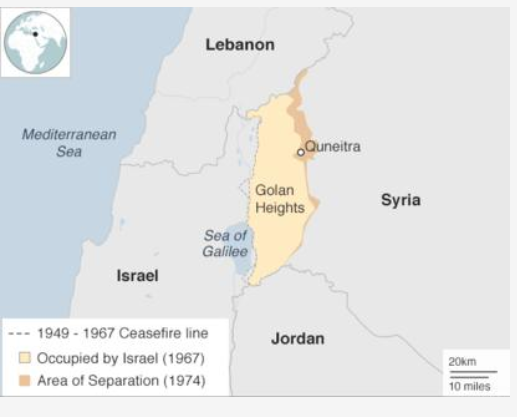
About Golan Heights
- The Golan Heights is a rocky plateau with an area of 1,800km² on the border between Israel and Syria in south-western Syria.
- Israel occupied the Golan Heights, West Bank, East Jerusalem, and the Gaza Strip in the 1967 Six-Day War.An armistice line was established and the region came under Israeli military control.
- Syria tried to retake the Golan Heights during the 1973 Middle East war. Syria was defeated in its attempt.
- Both countries signed an armistice in 1974 and a UN observer force has been in place on the ceasefire line since 1974.
- In 1981, Israel permanently acquired the territory of the Golan Heights and East Jerusalem in moves never recognized by most countries.
- The international community regards as disputed territory occupied by Israel whose status should be determined by negotiations between Israel and Syria.
- Attempts by the international community to bring Israel and Syria for negotiations have failed.
Potential Regional Conflict:
- The incident heightens fears of a broader regional conflict, with increased military activity along the Israel-Lebanon border.
5. Stanford Study Reveals AI Language Gaps, Highlights Global Technological Inequities
(Source: Indian Express; Section: The World; Page: 14)
|
Context: |
|
Analysis of News:
- Test Findings: Stanford researchers tested the AI chatbot Claude 3.5 by Anthropic in Vietnamese, asking it to write a traditional poem and identify a specific family relationship term. The AI failed to follow the poetic format and provided incorrect terminology, highlighting its limitations in handling non-English languages.
- Global Language Inequities: The flaws observed are common across AI models when dealing with languages outside standard American English. This is attributed to the dominance of English in AI training datasets, which often neglect “low-resource” languages like Vietnamese, Hindi, Bengali, and Swahili.
- Implications: The language gap in AI technologies could exacerbate global technological and economic disparities, as many regions and cultures may be left behind. Access to advanced AI tools in local languages is crucial for ensuring equitable benefits and avoiding economic delays.
- Security Concerns: There are also security risks, as insufficient training in non-English languages may allow users to bypass safety protocols, potentially accessing harmful information.
- Data Scarcity: The scarcity of digital data in low-resource languages limits the ability of AI to learn and perform accurately, underlining the need for broader data inclusion in AI development.



